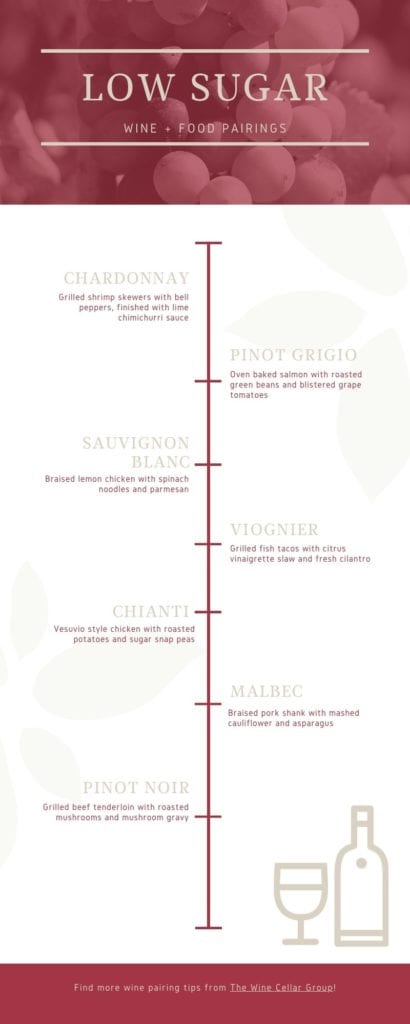At The Wine Cellar Group, we know that we have to practice moderation when indulging in our favorite wines. While wine does have great health benefits associated with it, we make a conscious effort to provide options for those who are interested in keeping their sugar intake low or want organic wine options.
Organic, low sugar, sugar free wines, and low sulfate wines are great options if you’re looking for something lighter to drink, while also sticking to those New Year’s resolutions and intentions that you set. Read on for helpful tips and wine suggestions to try.
What Is Low Sugar Wine?
What determines the sweetness and sugar levels of a wine? Fermentation! When less sugar is fermented, more stays in the natural fruit. Sweet white wines (Moscato, German Riesling, and Spätlese) yield a shorter fermentation time, making it sweeter on the tongue.
Wines Without Added Sugar
Are there sugar free wines? Dry white wines (Sauvignon Blanc, Chardonnay, and Pinot Grigio) have a longer fermentation period. Because of this, not much of the natural sugar is left in the grape, producing a drier taste on the palette. These wines typically have 1-3 grams of sugar per 5-ounce pour. While not entirely zero sugar, these are as close to organic sugar free wine as you can get. Many people tend to drink wines Cabernet Sauvignon, Merlot and Pinot Noir in moderation when adhering to a keto diet or after over-indulging during holiday meals.
Sweet red wines (Tawny Port, Port, and Banyuls) are typically fermented with fruits other than grapes, think figs, dates, etc. These fruits have a natural sweetness that add sugar and flavor. Similar to dry white wines, dry red wines (Italian Chianti, Pinot Noir, Malbec, and Zinfandel) are also lower in sugar (1-3 grams per 5-ounce), fermented for much longer, and more tannic. A few dry red wine varietals include Italian Chianti, Pinot Noir, Malbec, and Zinfandel.
What Kind of Wine Has the Lowest Sugar?
Dry reds often are amongst the lowest sugar content amongst wines and often contain around one gram of sugar per five-ounce pour. Some of these include Pinot Noir, Cabernet Sauvignon, and Syrah/Shiraz. Dry whites, which have between one and 1.5 grams of sugar per five ounces such as Pinot Grigio, Chardonnay, and Viognier.
Get updates on new sugar free & organic wines at The Wine Cellar Group as they arrive!
Low Sugar Wines
Dry white wines are typically low in sugar (natural and added) and rely on the grapes for any sort of sweetness. French Chardonnay, Italian Pinot Grigio, and Marlborough or French Sauvignon Blanc are some of our favorites! Give one of these Cellar Collection whites a try.
Low Sugar Wine Pairings
Drinking low sugar wine and organic wines doesn’t mean giving up flavorful food and wine pairings! There are plenty of delicious options to go along with our selections. Check out some of our favorite low sugar wines and suggested pairings below that will leave you feeling healthier in the new year. Cheers!

| Low Sugar Wine | Suggested Food Pairing |
|
Chardonnay |
Grilled shrimp skewers with bell peppers, finished with lime chimichurri sauce |
|
Pinot Grigio |
Oven baked salmon with roasted green beans and blistered grape tomatoes |
|
Sauvignon Blanc |
Braised lemon chicken with spinach noodles and parmesan |
|
Viognier |
Grilled fish tacos with citrus vinaigrette slaw and fresh cilantro |
|
Chianti |
Vesuvio style chicken with roasted potatoes and sugar snap peas |
|
Malbec |
Braised pork shank with mashed cauliflower and asparagus |
|
Pinot Noir |
Grilled beef tenderloin with roasted mushrooms and mushroom gravy |
What Is Organic Wine?
To be labeled as an organic wine, producers need to go through a rigorous process of certification and the grapes need to be grown without the use of artificial or synthetic chemicals, such as herbicides and pesticides. Many organic and sustainable vineyards also consider the water used in their irrigation practices and other earth-friendly growing practices!
Our wine stores now offer two new organic wine lines: Amore Organic Blends and Chaval Organic Wines. Both vineyards are certified organic and use a blend of locally grown grapes as well as internationally imported grapes.
Low Sulfite Wine
Sulfites are one of the most often discussed aspects of wine. There is no such thing as a 100% sulfite-free wine. Sulfur dioxide (SO2) is a natural compound that is always produced during fermentation. This helps preserve freshness and prevents oxidation, which leads to that vinegar taste spoiled wine can have. Sulfur is also a natural anti-microbial agent; it keeps your wine from spoiling too quickly. Red wines tend to be lower in sulfites, due to their ability to rest and age. White wines require more sulfites to keep them fresh and to slow down the aging process.
Which Wine is Lowest in Sulfites?
Red wine is naturally low in sulfites because red wine contains more tannins than white wine, giving reds more antioxidants. Antioxidants help preserve wine by maintaining a wine’s bright colors, preserving taste and keeping it bacteria free without the need for extra attention and care from winemakers.
Do organic wines have less sulfites?
Organic wines made in the United States have no added sulfites. For wines that are “made with organic grapes”, sulfur dioxide may be added to yield fewer than 100 ppm (parts per million). Fermented alcoholic beverages made in the United States often have sulfites added to prevent oxidation of wine, beer and other alcoholic beverages. Foods that are not processed have less sulfites than foods that are processed with sulfur dioxide. Natural wines in the United States may contain up to 10ppm of sulfur dioxide. Any wines that contain more than 10ppm requires labeling so make sure to check those labels.
Organic wines also have less additives, so they’re a great source if you’re looking for lower sulfite wines!
| Cellar Collection Suggestion | Suggested Food Pairing
|
The Wine Cellar Group offers a wide selection of wines from around the world. What Cellar Collection wine are you currently drinking? Share your photos with us! Tag @thewinecellargroup and use #TheWineCellarGroup for a chance to be featured on our page. Join our email list for more fun wine tips, deals, and upcoming events!






2 Comments
Very helpful. Always wondered how to determine a wines sugar content since it’s not on the label
Hi Jerry, we’re glad you read and enjoyed our blog post. Cheers! Aleah from the Wine Cellar Group.